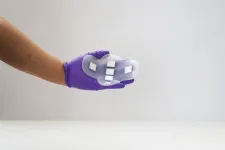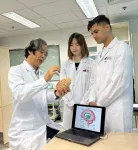(Press-News.org) CAMBRIDGE, MA -- MIT researchers have designed a wearable ultrasound monitor, in the form of a patch, that can image organs within the body without the need for an ultrasound operator or application of gel.
In a new study, the researchers showed that their patch can accurately image the bladder and determine how full it is. This could help patients with bladder or kidney disorders more easily track whether these organs are functioning properly, the researchers say.
This approach could also be adapted to monitor other organs within the body by changing the location of the ultrasound array and tuning the frequency of the signal. Such devices could potentially enable earlier detection of cancers that form deep within the body, such as ovarian cancer.
“This technology is versatile and can be used not only on the bladder but any deep tissue of the body. It’s a novel platform that can do identification and characterization of many of the diseases that we carry in our body,” says Canan Dagdeviren, an associate professor in MIT’s Media Lab and the senior author of the study.
Lin Zhang, an MIT research scientist; Colin Marcus, an MIT graduate student in electrical engineering and computer science; and Dabin Lin, a professor at Xi’an Technological University, are the lead authors of a paper describing the work, which appears today in Nature Electronics.
Wearable monitoring
Dagdeviren’s lab, which specializes in designing flexible, wearable electronic devices, recently developed an ultrasound monitor that can be incorporated into a bra and used to screen for breast cancer. In the new study, the team used a similar approach to develop a wearable patch that can adhere to the skin and take ultrasound images of organs located within the body.
For their first demonstration, the researchers decided to focus on the bladder, partly inspired by Dagdeviren’s younger brother, who was diagnosed with kidney cancer a few years ago. After having one of his kidneys surgically removed, he had difficulty fully emptying his bladder. Dagdeviren wondered if an ultrasound monitor that reveals how full the bladder is might help patients similar to her brother, or people with other types of bladder or kidney problems.
“Millions of people are suffering from bladder dysfunction and related diseases, and not surprisingly, bladder volume monitoring is an effective way to assess your kidney health and wellness,” she says.
Currently, the only way to measure bladder volume is using a traditional, bulky ultrasound probe, which requires going to a medical facility. Dagdeviren and her colleagues wanted to develop a wearable alternative that patients could use at home.
To achieve that, they created a flexible patch made of silicone rubber, embedded with five ultrasound arrays made from a new piezoelectric material that the researchers developed for this device. The arrays are positioned in the shape of a cross, which allows the patch to image the entire bladder, which is about 12 by 8 centimeters when full.
The polymer that makes up the patch is naturally sticky and adheres gently to the skin, making it easy to attach and detach. Once placed on the skin, underwear or leggings can help to hold it in place.
Bladder volume
In a study performed with collaborators at the Center for Ultrasound Research and Translation and Department of Radiology at Massachusetts General Hospital, the researchers showed that the new patch could capture images comparable to those taken with a traditional ultrasound probe, and these images could be used to track changes in bladder volume.
For the study, the researchers recruited 20 patients with a range of body mass indexes. Subjects were first imaged with a full bladder, then with a partially empty bladder, and then with a completely empty bladder. The images obtained from the new patch were similar in quality to those taken with traditional ultrasound, and the ultrasound arrays worked on all subjects regardless of their body mass index.
Using this patch, no ultrasound gel is needed, and no pressure needs to be applied, as with a regular ultrasound probe, because the field of view is large enough to encompass the entire bladder.
To see the images, the researchers connected their ultrasound arrays to the same kind of ultrasound machine used in medical imaging centers. However, the MIT team is now working on a portable device, about the size of a smartphone, that could be used to view the images.
“In this work, we have further developed a path toward clinical translation of conformable ultrasonic biosensors that yield valuable information about vital physiologic parameters. Our group hopes to build on this and develop a suite of devices that will ultimately bridge the information gap between clinicians and patients,” says Anthony E. Samir, director of the MGH Center for Ultrasound Research and Translation and Associate Chair of Imaging Sciences at MGH Radiology, who is also an author of the study.
The MIT team also hopes to develop ultrasound devices that could be used to image other organs within the body, such as the pancreas, liver, or ovaries. Based on the location and depth of each organ, the researchers need to alter the frequency of the ultrasound signal, which requires designing new piezoelectric materials. For some of these organs, located deep within the body, the device may work better as an implant rather than a wearable patch.
“For whatever organ that we need to visualize, we go back to the first step, select the right materials, come up with the right device design and then fabricate everything accordingly,” before testing the device and performing clinical trials, Dagdeviren says.
“This work could develop into a central area of focus in ultrasound research, motivate a new approach to future medical device designs, and lay the groundwork for many more fruitful collaborations between materials scientists, electrical engineers, and biomedical researchers,” says Anantha Chandrakasan, dean of MIT’s School of Engineering, the Vannevar Bush Professor of Electrical Engineering and Computer Science, and an author of the paper.
###
The research was funded by a National Science Foundation CAREER award, a 3M Non-Tenured Faculty Award, the Sagol Weizmann-MIT Bridge Program, Texas Instruments Inc., the MIT Media Lab Consortium, a National Science Foundation Graduate Research Fellowship, and an ARRS Scholar Award.
END
A new ultrasound patch can measure how full your bladder is
The new wearable device, designed to monitor bladder and kidney health, could be adapted for earlier diagnosis of cancers deep within the body
2023-11-16
ELSE PRESS RELEASES FROM THIS DATE:
Cognitive and emotional well-being of preschool children before and during the pandemic
2023-11-16
About The Study: Pandemic-exposed children (assessment after March 11, 2020) had significantly higher problem solving and fine motor skills at 24 months of age but lower personal-social skills compared with non-exposed children in this study including data from the Ontario Birth Study. At 54 months of age, pandemic-exposed children had significantly higher vocabulary, visual memory, and overall cognitive performance compared with non-exposed children.
Authors: Mark Wade, Ph.D., C.Psych., of the University of Toronto, is the corresponding author.
To access the embargoed study: Visit our For The Media website ...
Social determinants of health and perceived barriers to care in diabetic retinopathy screening
2023-11-16
About The Study: This study of 11,000 participants with type 2 diabetes found that food insecurity, housing insecurity, mental health concerns, and the perceived importance of practitioner concordance were associated with a lower likelihood of receiving eye care. Such findings highlight the self-reported barriers to seeking care and the importance of taking steps to promote health equity.
Authors: Sophia Y. Wang, M.D., M.S., of Stanford University in Palo Alto, California, is the corresponding author.
To access the embargoed study: Visit our For The Media website at this link https://media.jamanetwork.com/
(doi:10.1001/jamaophthalmol.2023.5287)
Editor’s ...
Pushing the boundaries of eco-friendly chemical production
2023-11-16
A team of pioneering researchers from the Center for Advanced Bioenergy and Bioproducts Innovation (CABBI) has made a significant leap forward in the complex world of molecular chemistry.
Their focus? Azaarenes, unique molecular puzzle pieces crucial to many everyday products, from eco-friendly agrochemicals to essential medicines. The CABBI team demonstrated an innovative way to modify these molecules, a groundbreaking discovery that holds promise for new industrially relevant chemical reactions and sustainable energy solutions.
Central to their ...
Hospitals serving large Black, Hispanic populations have fewer resources for cancer care
2023-11-16
Key takeaways
UCLA researchers looked at nearly 4,400 hospitals across the U.S., including 864 with high numbers of Black and Hispanic patients.
Hospitals serving Black, Hispanic and other racial and ethnic minority patients were significantly less likely than other hospitals to have access to core cancer services like PET/CT scanners, robotic surgery and palliative care.
The researchers say further work is need to understand how geographic, linguistic, cultural, cost and discrimination factors affect these cancer care disparities.
Among the nation’s ...
Introducing EUGENe: an easy-to-use deep learning genomics software
2023-11-16
Deep learning — a form of artificial intelligence capable of improving itself with limited user input — has radically reshaped the landscape of biomedical research since its emergence in the early 2010s. It’s been particularly impactful in genomics, a field of biology that examines how our DNA is organized into genes and how these genes are activated or deactivated in individual cells. Despite this synergy, genomics researchers wanting to employ this technology are often challenged by the actual coding necessary to analyze vast pools of dense data.
Now, ...
Hunger hormones impact decision-making brain area to drive behavior
2023-11-16
A hunger hormone produced in the gut can directly impact a decision-making part of the brain in order to drive an animal’s behaviour, finds a new study by UCL (University College London) researchers.
The study in mice, published in Neuron, is the first to show how hunger hormones can directly impact activity of the brain’s hippocampus when an animal is considering food.
Lead author Dr Andrew MacAskill (UCL Neuroscience, Physiology & Pharmacology) said: “We all know our decisions ...
Epidemic-economic model provides answers to key pandemic policy questions
2023-11-16
University of Oxford news release
Institute of New Economic Thinking
Embargoed until Thursday, 16 November 2023, 16:00 GMT
Is lockdown an effective response to a pandemic, or would it be better to let individuals spontaneously reduce their risk of infection? Research published today suggests these two highly-debated options lead to similar outcomes.
A ground-breaking economic-pandemic model, created by an international team of researchers, addresses some of the key policy debates of the Covid-19 pandemic but it ...
New research advances understanding of cancer risk in gene therapies
2023-11-16
Medical research has shown promising results regarding the potential of gene therapy to cure genetic conditions such as sickle cell disease and the findings of this study, published in Nature Medicine, offer important new insights into processes happening in the body after treatment.
The present study looked at samples from six patients with sickle cell disease who were undergoing gene therapy as part of a major clinical trial at Boston Children’s Hospital. The research brought together an international team of experts, to take a closer look at the genetic changes in the stem cells of patients before and after gene therapy ...
A small molecule blocks aversive memory formation, providing a potential treatment target for depression
2023-11-16
Depression is one of the most common mental illnesses in the world, but current anti-depressants have yet to meet the needs of many patients. Neuroscientists from City University of Hong Kong (CityU) recently discovered a small molecule that can effectively alleviate stress-induced depressive symptoms in mice by preventing aversive memory formation with a lower dosage, offering a new direction for developing anti-depressants in the future.
“Depression affects millions of individuals worldwide, necessitating more effective treatments. Conventional methods, such as drug therapy with delayed onset of action and psychotherapy, have limitations in yielding satisfactory ...
Plants that survived dinosaur extinction pulled nitrogen from air
2023-11-16
DURHAM, N.C. -- Once a favored food of grazing dinosaurs, an ancient lineage of plants called cycads helped sustain these and other prehistoric animals during the Mesozoic Era, starting 252 million years ago, by being plentiful in the forest understory. Today, just a few species of the palm-like plants survive in tropical and subtropical habitats.
Like their lumbering grazers, most cycads have gone extinct. Their disappearance from their prior habitats began during the late Mesozoic and continued into the early Cenozoic Era, punctuated by the cataclysmic asteroid impact and volcanic activity that mark the K-Pg boundary 66 million years ago. However, unlike the dinosaurs, somehow a few groups ...
LAST 30 PRESS RELEASES:
Structural findings reveal how distinct GPCR ligands create different levels of activation
Anything-goes “anyons” may be at the root of surprising quantum experiments
UC review: Maximizing workplace opportunity for veterans
From generation to complex control: Metasurfaces make perfect vortex beams "within reach"
Thin-film lithium niobate-based detector: recent advances and perspectives
Exploring why some people may tend to persistently make bad choices
How cells balance their protein levels
Nirsevimab vs RSVpreF vaccine for RSV–related hospitalization in newborns
Effectiveness and impact of maternal RSV immunization and nirsevimab on medically attended RSV in US children
AI gives scientists a boost, but at the cost of too many mediocre papers
Next-generation vision model maps tree growth at sub-meter precision
Genes aren’t destiny for inherited blindness, study shows
MIT study: High-fat diets make liver cells more likely to become cancerous
Exposure to multiple fine particulate matter components and incident depression in the US Medicare population
Risk of burdensome health care spending over time in the US
Nirsevimab against hospitalizations and emergency department visits for lower respiratory tract infection in infants
New microfluidics technology enables highly uniform DNA condensate formation
A new strategy for immune tolerance
Super Mario Bros. help fight burnout: New study links classic games to boosted happiness
Deepest gas hydrate cold seep ever discovered in the arctic: International research team unveils Freya Hydrate Mounds at 3,640 m depth.
Integrating light and structure: Smarter mapping for fragile wetland ecosystems
ACA-SIM: A robust way to decode satellite signals over complex waters
Probiotics can restore gut microbiome in breastfed infants
AI could help predict nutrition risks in ICU patients, study finds
Federal EITC has unexpected result, researchers say – it decreases domestic violence
Researchers identify gene that calms the mind and improves attention in mice
Artificial metabolism turns waste CO2 into useful chemicals
Ancient sea anemone sheds light on animal cell type evolution
Begging gene leads to drone food
How climate policies that incentivize and penalize can drive the clean energy transition
[Press-News.org] A new ultrasound patch can measure how full your bladder isThe new wearable device, designed to monitor bladder and kidney health, could be adapted for earlier diagnosis of cancers deep within the body






